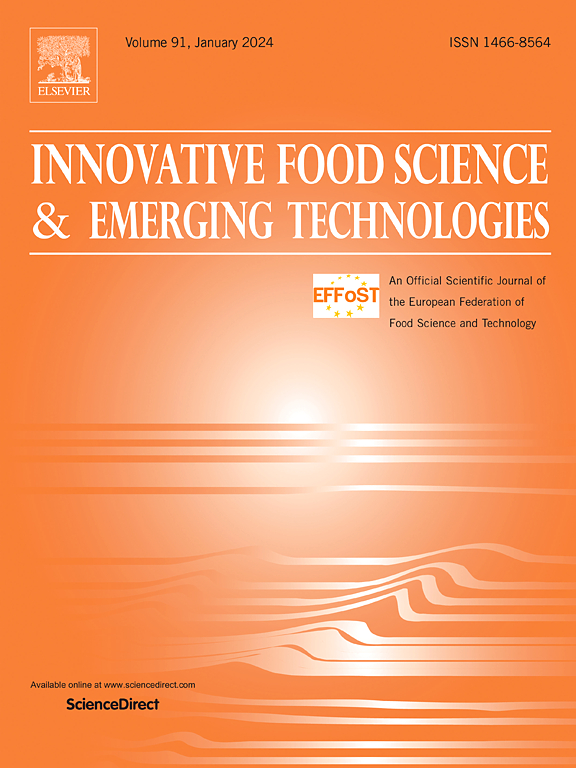Natural deep eutectic solvents: A sustainable approach for extracting protein and chitin from Tenebrio molitor beetles
IF 6.8
1区 农林科学
Q1 FOOD SCIENCE & TECHNOLOGY
Innovative Food Science & Emerging Technologies
Pub Date : 2025-07-05
DOI:10.1016/j.ifset.2025.104104
引用次数: 0
Abstract
Natural deep eutectic solvents (NADES) permit extract protein from different biomasses without using harsh chemicals. In this work, varied NADES were studied to maximize the protein extraction from Tenebrio molitor beetles, assessing the effect of time, temperature and water addition. Higher protein yield was obtained using NADES formed with choline chloride and oxalic acid (34.1 %) and betaine and urea (Bet:Ur, 32.8 %). Higher quantity of solid enriched in chitin (56.5 % DW) was obtained using a mixture of choline chloride and glycine (1:2 M ratio). Following the optimization of NADES-based treatment, maximum protein hydrolysis (81.5 %) was obtained using Bet:Ur at 1:2 molar ratio, 30 % of water, at 90 °C, for 3 h. The protein obtained after the optimized conditions was characterized, showing high in vitro digestibility (93.8 %), 6.04 % and 5.60 % of water and oil holding capacity, respectively. Scaling-up the treatment up to 50 g of beetles' meal resulted in 91.5 % of protein hydrolysis. Also, the reuse of NADES did not compromise the protein hydrolysis, achieving 61 % on the first cycle, followed by 58 % and 48 % at the second and third cycle, respectively. This work evidence that using a NADES of betaine and urea and optimal conditions resulted in a high-quality protein, minimizing the disposal of insect by-products.
天然深层共晶溶剂:从黄粉虫中提取蛋白质和几丁质的可持续方法
天然深共熔溶剂(NADES)允许从不同的生物质中提取蛋白质,而无需使用苛刻的化学物质。本文研究了不同的NADES,以最大限度地提高黄粉虫蛋白质的提取率,并评估了时间、温度和水的影响。用氯化胆碱与草酸(34.1%)和甜菜碱与尿素(Bet:Ur, 32.8%)形成的NADES可获得较高的蛋白质收率。氯化胆碱与甘氨酸的混合物(1:2 M比)可获得较高的甲壳素富集固体量(56.5% DW)。经过优化的nades处理,在1:2摩尔比、30%水、90°C、3 h的条件下,Bet:Ur的蛋白质水解率最高,达到81.5%。优化后的蛋白质体外消化率为93.8%,持水率为6.04%,持油率为5.60%。将处理规模扩大到50克甲虫粉,导致91.5%的蛋白质水解。此外,NADES的重复使用不会影响蛋白质的水解,在第一个循环中达到61%,其次是58%和48%,在第二和第三个循环中分别。这项工作证明,使用甜菜碱和尿素的NADES和最佳条件产生了高质量的蛋白质,最大限度地减少了昆虫副产品的处理。
本文章由计算机程序翻译,如有差异,请以英文原文为准。
求助全文
约1分钟内获得全文
求助全文
来源期刊
CiteScore
12.00
自引率
6.10%
发文量
259
审稿时长
25 days
期刊介绍:
Innovative Food Science and Emerging Technologies (IFSET) aims to provide the highest quality original contributions and few, mainly upon invitation, reviews on and highly innovative developments in food science and emerging food process technologies. The significance of the results either for the science community or for industrial R&D groups must be specified. Papers submitted must be of highest scientific quality and only those advancing current scientific knowledge and understanding or with technical relevance will be considered.

 求助内容:
求助内容: 应助结果提醒方式:
应助结果提醒方式:


